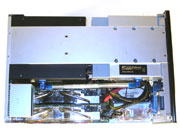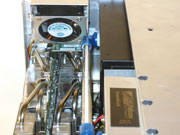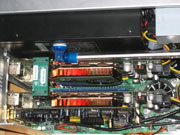Falcon Northwest FragBox SLI: Dare to Dream
by Jarred Walton on May 3, 2006 9:00 AM EST- Posted in
- Systems
Features
We've talked about the appearance of the case, and we've talked about prices. There's a reason for the prices, of course, and that's the features, components, and performance that you get with the system. It's no secret that you get greatly diminishing returns on many hardware upgrades. A $1000 system is rarely twice as fast as a $500 system - at least, if you discount the difference in performance between IGP and a discrete graphics card - and $2000 systems are even less of a performance jump from $1000 builds. Doubling or tripling cost to get into the $5000+ range will get you about the fastest system currently available, but many of the components will carry a 10-20% performance increase for twice the cost. So here's a look at the components Falcon includes in one of their top FragBox SLI systems.
Fastest CPU currently on the market? Check. Fastest graphics cards currently on the market? Check - at least somewhat. See, NVIDIA is launching their Quad-SLI platform, and the system as tested "only" comes with two 7900 GTX 512MB cards - BFG overclocked models, no less. If you want Quad-SLI, Falcon can actually work that into the FragBox case as well. Who needs Quad-SLI? To paraphrase Kelt Reeves, it's pretty much only for the filthy rich people running around with 30" Apple Cinema (or Dell 3007FPW) displays; 2560x1600 can actually bring even a mighty 7900 GTX 512 SLI or X1900 XT CrossFire setup to its knees.
What was that about using the FragBox with X1900 CrossFire? As you're likely aware by now, CrossFire and SLI are competing standards, and both companies currently refuse to allow their multi-GPU setup to run on the other's chipsets. ATI has at least worked with Intel to get CF running on 975X, but what we'd really like to see is for both companies to take off the shackles and let people use whatever multi-GPU setup they want on any motherboard with dual X16 PCIe slots. The uATX/SFF market needs help even more, as only recently have we managed to get an SLI uATX board and there are still no CF uATX designs. Given that there are quite a few games where X1900 XT CF comes out ahead of 7900 GTX SLI these days (and of course there are still areas where NVIDIA leads ATI), ideally the decision of what GPUs to run should be up to the customer. We don't need official support for CrossFire on SLI or SLI on CrossFire, but we'd love to see the driver locks removed once and for all. Is it likely to happen? No, but as we said at the start, dreams are free.
Other areas continue to go ultra-high-end as well. The system has two 150GB Raptor drives in RAID 0. If you prefer, you can get a couple 400GB Seagate drives for less money, or you can go for a full terabyte of storage complements of two 500GB Seagate drives for even more money than the Raptors. If you don't want RAID 0, you can also opt out of that feature and simply have one or two drives installed, or you can go with the safer route and have the system configured for RAID 1.
The one area that falls short is the audio. Realtek ALC850 isn't terrible, but it certainly isn't as good as even the original Audigy, let alone many of the other high-end sound cards. We talked with Falcon about that and asked to get a couple 7900 GT cards with an X-Fi sound card to use as an alternate configuration. Sure, you sacrifice some GPU performance, but depending on the monitor and resolution you run, it may or may not matter. The Realtek ALC850 is adequate for most tasks, but even with $55 Logitech speakers there was a clear difference in quality between the integrated audio and the X-Fi card. If you're planning on connecting the FragBox to some really nice speakers or headphones, we would seriously consider upgrading the audio subsystem. (That might mean you have to ditch the FragBox and go for the full Mach V setup if you're looking at FNW systems.)
So the system comes equipped with the best parts money can buy, but there's still the problem of that price sticker, right? How can anyone justify spending thousands of dollars on a computer? FNW charges a pretty hefty price premium for putting your system together, but they really do go all out in building and testing the system. Included with every FNW computer is a binder of documentation, and part of the documentation lists performance and stress testing results. Scores from all three of the latest Futuremark 3DMark applications are listed, so you can always refer back to them to verify whether or not your system continues to run at peak performance. There is also a total of about 3 days of stress testing conducted on the systems, including running Prime95 (one instance per CPU core) for 12 hours and a loop of 3DMark06 for 12 hours. You can be relatively sure that whatever FNW ships out will run fully stable - just remember to "pop the hood" and dust out the fans and heatsinks twice a year to maintain optimal heat dissipation. What it boils down to is that Falcon employs some very knowledgeable technicians, and if you want a really skilled computer person assembling and troubleshooting your system, you're going to pay extra. For some people, it's worth the peace of mind and support that you get.
The rest of the documentation provided with the system is also superb, and echoes my feelings on several points. For example, they suggest installing all of your games into C:\Games rather than into the default directory. This helps to keep your hard drive more organized, as the Program Files folder has simply turned into the new root directory as far as applications are concerned. Let's not even get into the discussion about games that install to C:\Program Files\[Publisher]\[Developer]\[Game Name] -- even when the developers haven't released any other games! I can't say that I really learned anything new from the manual and documentation, but it does have quite a few pointers that many people (and companies) could find useful.
We've talked about the appearance of the case, and we've talked about prices. There's a reason for the prices, of course, and that's the features, components, and performance that you get with the system. It's no secret that you get greatly diminishing returns on many hardware upgrades. A $1000 system is rarely twice as fast as a $500 system - at least, if you discount the difference in performance between IGP and a discrete graphics card - and $2000 systems are even less of a performance jump from $1000 builds. Doubling or tripling cost to get into the $5000+ range will get you about the fastest system currently available, but many of the components will carry a 10-20% performance increase for twice the cost. So here's a look at the components Falcon includes in one of their top FragBox SLI systems.
| Falcon Northwest FragBox SLI | |
| Motherboard: | EVGA 131-K8-NF44-AX NF4 SLI (NVIDIA nForce4 SLI chipset) Micro-ATX |
| Processor: | Socket 939 CPU up through FX-60 |
| Heatsink/Cooling: | Zalman CNPS7000Cu (most 939 HSFs will fit) 1 x 40mm rear fan; 1 x 80mm HDD fan; 1 x 120mm PSU fan |
| RAM: | Four DIMM slots supporting up to 4GB DDR200 through DDR400 |
| Expansion Slots: | 2 x PCIe X16 with X8 data connections (including SLI bridge connector) 1 x PCIe X16 with either X1 or X16 (configured by jumpers) 1 x PCI |
| Expansion Bays: | 2 x 3.5 inch internal bays 1 x 3.5 inch external 1 x 5.25 inch external |
| Audio: | RealTek AC'97 7.1 (ALC850) |
| Power Suply: | SilverStone 600W Modular PSU 1 x 24-pin; 1 x ATX12V; 4 x SATA; 5 x 4-pin Molex; 1 x mini Molex (floppy) 2 x PCIe 6-pin Additional cables can be added if necessary |
| Motherboard Connections: | 1 X FDD 1 X IDE 4 X SATA 3.0Gbps 5 x 3-pin fan headers 24-pin ATX; ATX12X; 1 x Molex |
| Front Ports: | 2 X USB2.0 1 x 6-pin FireWire 2 X 3.5mm Audio (Headphone and Microphone) |
| Rear Ports: | 4 X USB2.0 1 X FireWire (6-pin) 6 X 3.5mm Audio S/PDIF Optical and Coax Out PS/2 Keyboard and Mouse LAN (GbE) 1 X Serial and 1 X Parallel |
| Extras: | 8-inch cold cathode light Acrylic faceplate with logo and light On/Off switch for lights on rear of case Carrying handle on top (removable) Case windows on left and right |
Fastest CPU currently on the market? Check. Fastest graphics cards currently on the market? Check - at least somewhat. See, NVIDIA is launching their Quad-SLI platform, and the system as tested "only" comes with two 7900 GTX 512MB cards - BFG overclocked models, no less. If you want Quad-SLI, Falcon can actually work that into the FragBox case as well. Who needs Quad-SLI? To paraphrase Kelt Reeves, it's pretty much only for the filthy rich people running around with 30" Apple Cinema (or Dell 3007FPW) displays; 2560x1600 can actually bring even a mighty 7900 GTX 512 SLI or X1900 XT CrossFire setup to its knees.
 |
 |
 |
| Click to enlarge | ||
What was that about using the FragBox with X1900 CrossFire? As you're likely aware by now, CrossFire and SLI are competing standards, and both companies currently refuse to allow their multi-GPU setup to run on the other's chipsets. ATI has at least worked with Intel to get CF running on 975X, but what we'd really like to see is for both companies to take off the shackles and let people use whatever multi-GPU setup they want on any motherboard with dual X16 PCIe slots. The uATX/SFF market needs help even more, as only recently have we managed to get an SLI uATX board and there are still no CF uATX designs. Given that there are quite a few games where X1900 XT CF comes out ahead of 7900 GTX SLI these days (and of course there are still areas where NVIDIA leads ATI), ideally the decision of what GPUs to run should be up to the customer. We don't need official support for CrossFire on SLI or SLI on CrossFire, but we'd love to see the driver locks removed once and for all. Is it likely to happen? No, but as we said at the start, dreams are free.
Other areas continue to go ultra-high-end as well. The system has two 150GB Raptor drives in RAID 0. If you prefer, you can get a couple 400GB Seagate drives for less money, or you can go for a full terabyte of storage complements of two 500GB Seagate drives for even more money than the Raptors. If you don't want RAID 0, you can also opt out of that feature and simply have one or two drives installed, or you can go with the safer route and have the system configured for RAID 1.
 |
 |
| Click to enlarge | |
The one area that falls short is the audio. Realtek ALC850 isn't terrible, but it certainly isn't as good as even the original Audigy, let alone many of the other high-end sound cards. We talked with Falcon about that and asked to get a couple 7900 GT cards with an X-Fi sound card to use as an alternate configuration. Sure, you sacrifice some GPU performance, but depending on the monitor and resolution you run, it may or may not matter. The Realtek ALC850 is adequate for most tasks, but even with $55 Logitech speakers there was a clear difference in quality between the integrated audio and the X-Fi card. If you're planning on connecting the FragBox to some really nice speakers or headphones, we would seriously consider upgrading the audio subsystem. (That might mean you have to ditch the FragBox and go for the full Mach V setup if you're looking at FNW systems.)
So the system comes equipped with the best parts money can buy, but there's still the problem of that price sticker, right? How can anyone justify spending thousands of dollars on a computer? FNW charges a pretty hefty price premium for putting your system together, but they really do go all out in building and testing the system. Included with every FNW computer is a binder of documentation, and part of the documentation lists performance and stress testing results. Scores from all three of the latest Futuremark 3DMark applications are listed, so you can always refer back to them to verify whether or not your system continues to run at peak performance. There is also a total of about 3 days of stress testing conducted on the systems, including running Prime95 (one instance per CPU core) for 12 hours and a loop of 3DMark06 for 12 hours. You can be relatively sure that whatever FNW ships out will run fully stable - just remember to "pop the hood" and dust out the fans and heatsinks twice a year to maintain optimal heat dissipation. What it boils down to is that Falcon employs some very knowledgeable technicians, and if you want a really skilled computer person assembling and troubleshooting your system, you're going to pay extra. For some people, it's worth the peace of mind and support that you get.
The rest of the documentation provided with the system is also superb, and echoes my feelings on several points. For example, they suggest installing all of your games into C:\Games rather than into the default directory. This helps to keep your hard drive more organized, as the Program Files folder has simply turned into the new root directory as far as applications are concerned. Let's not even get into the discussion about games that install to C:\Program Files\[Publisher]\[Developer]\[Game Name] -- even when the developers haven't released any other games! I can't say that I really learned anything new from the manual and documentation, but it does have quite a few pointers that many people (and companies) could find useful.










32 Comments
View All Comments
segagenesis - Wednesday, May 3, 2006 - link
Obviously this wont be cheap, but what an interesting feat of engineering. For a SFF computer this should literally have flames shooting out the back.Gary Key - Wednesday, May 3, 2006 - link
If they had utilized a Pentium 955EE it would have had flames coming out from all directions. :) Just kidding, not really, but we found it amazing how well this case design took thermal requirements under consideration when utilizing SLI and a FX series processor.